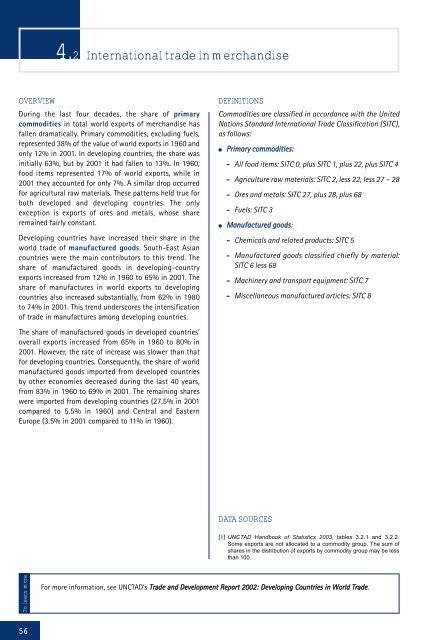Development and Globalization: - Unctad
Development and Globalization: - Unctad
Development and Globalization: - Unctad
You also want an ePaper? Increase the reach of your titles
YUMPU automatically turns print PDFs into web optimized ePapers that Google loves.
OVERVIEW DEFINITIONS<br />
During the last four decades, the share of primary<br />
commodities in total world exports of merch<strong>and</strong>ise has<br />
fallen dramatically. Primary commodities, excluding fuels,<br />
represented 38% of the value of world exports in 1960 <strong>and</strong><br />
only 12% in 2001. In developing countries, the share was<br />
initially 63%, but by 2001 it had fallen to 13%. In 1960,<br />
food items represented 17% of world exports, while in<br />
2001 they accounted for only 7%. A similar drop occurred<br />
for agricultural raw materials. These patterns held true for<br />
both developed <strong>and</strong> developing countries. The only<br />
exception is exports of ores <strong>and</strong> metals, whose share<br />
remained fairly constant.<br />
Developing countries have increased their share in the<br />
world trade of manufactured goods. South-East Asian<br />
countries were the main contributors to this trend. The<br />
share of manufactured goods in developing-country<br />
exports increased from 12% in 1960 to 65% in 2001. The<br />
share of manufactures in world exports to developing<br />
countries also increased substantially, from 62% in 1980<br />
to 74% in 2001. This trend underscores the intensification<br />
of trade in manufactures among developing countries.<br />
The share of manufactured goods in developed countries’<br />
overall exports increased from 65% in 1960 to 80% in<br />
2001. However, the rate of increase was slower than that<br />
for developing countries. Consequently, the share of world<br />
manufactured goods imported from developed countries<br />
by other economies decreased during the last 40 years,<br />
from 83% in 1960 to 69% in 2001. The remaining shares<br />
were imported from developing countries (27.5% in 2001<br />
compared to 5.5% in 1960) <strong>and</strong> Central <strong>and</strong> Eastern<br />
Europe (3.5% in 2001 compared to 11% in 1960).<br />
To learn more<br />
56<br />
4.2 International trade in merch<strong>and</strong>ise<br />
Commodities are classified in accordance with the United<br />
Nations St<strong>and</strong>ard International Trade Classification (SITC),<br />
as follows:<br />
● Primary commodities:<br />
- All food items: SITC 0, plus SITC 1, plus 22, plus SITC 4<br />
- Agriculture raw materials: SITC 2, less 22, less 27 – 28<br />
- Ores <strong>and</strong> metals: SITC 27, plus 28, plus 68<br />
- Fuels: SITC 3<br />
● Manufactured goods:<br />
- Chemicals <strong>and</strong> related products: SITC 5<br />
- Manufactured goods classified chiefly by material:<br />
SITC 6 less 68<br />
- Machinery <strong>and</strong> transport equipment: SITC 7<br />
- Miscellaneous manufactured articles: SITC 8<br />
DATA SOURCES<br />
[1] UNCTAD H<strong>and</strong>book of Statistics 2003, tables 3.2.1 <strong>and</strong> 3.2.2.<br />
Some exports are not allocated to a commodity group. The sum of<br />
shares in the distribution of exports by commodity group may be less<br />
than 100.<br />
For more information, see UNCTAD’s TTrraaddee aanndd DDeevveellooppmmeenntt RReeppoorrtt 22000022:: DDeevveellooppiinngg CCoouunnttrriieess iinn WWoorrlldd TTrraaddee.

















